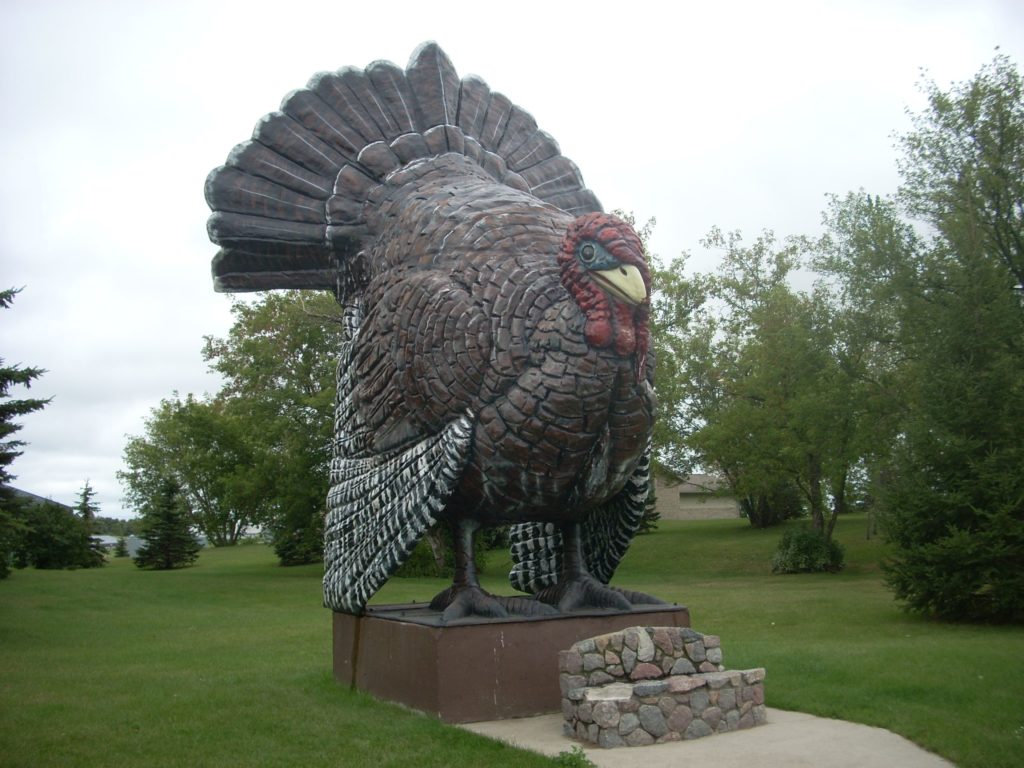by Laura Matanah, Executive Director
As the Executive Director of Minnesota’s largest farmed animal advocacy organization, I can’t help but reflect on the ways my experience of isolation following a positive COVID test is similar and different to the life of a turkey raised for the Thanksgiving table. To help us picture an individual, I’ll use the name Big Tom. I got this name from the name of the giant sculpted turkey outside of Frazee, MN. (Why is the sculpture there? Minnesota produces 45 million turkeys a year, more than any other state). Here I’ll describe the life of the Big Tom who lives in one of the sheds just off Minnesota Highway 10.
Big Tom and I are both closed off from the rest of the world. I have to be alone, but I’m in my comfortable room. My isolation lasts only ten days. My family helps from beyond the door. Big Tom has been in the same windowless shed since he was a young poult. Rather than being alone, he’s with thousands of other birds.The only light he gets is artificial, turned on to encourage him to eat, but kept low to discourage fighting with the stressed males around him. Droppings aren’t cleaned until after the turkeys leave for slaughter, so after four months, it reeks of ammonia despite the ventilation.
Big Tom gets disease protection from the antibiotics in his feed, a practice which also weakens the protection humans get from antibiotics. (In 2017, the World Health Organization (WHO) released guidelines calling for the elimination of routine use of antibiotics in food-producing animals, including for disease prevention purposes, but the U.S. has taken no action.)
But those antibiotics won’t protect him from the virus stalking him: bird flu. Bird Flu is now starting to outbreak in Europe and Asia. (https://www.theguardian.com/world/2021/nov/15/bird-flu-europe-asia) Frighteningly, it could become our next pandemic as well. The CDC is already preparing. (https://www.precisionvaccinations.com/us-cdc-prepares-potential-bird-flu-outbreak)
Many of us here in Minnesota get to see turkeys in the wild, and know they generally live in groups. Mothers and their young band together, living communally. This is a bit like my multi-generational household: all of us get more adults to share the responsibility of raising the young. Turkeys like Big Tom don’t get maternal care, however, just an incubator replaced by a shed filled with other un-mothered young like themselves.
Big Tom’s food and water wouldn’t vary, but would be steady. Because, of course, the point is for Big Tom to grow, and grow fast. If a human baby grew at the same rate as Big Tom, it would weigh 1,500 pounds by the age of 18 weeks!
Due to this high rate of growth, Big Tom is at high risk for abnormal gait, hip lesions, and skeletal disease. And if these issues eventually make it hard for him to get to his food and drink? Well, vet care for these issues isn’t cost effective, and losses are part of the business model.
Penny, who lived at Spring Farm Sanctuary, in Long Lake, got to live a very different life. There, his cognition, emotions, personality, and sociality were valued. His caregivers knew how to read her emotions by looking at his snood (the piece of flesh that dangles a bit over and alongside the beak). He could be with other birds and humans when he wished or retreat to his own private space of his own choosing, just like I can when not in isolation.
Due to antibiotics, bird flu, and the damage being done to human health by the overconsumption of animal products, our well being and that of Minnesota 45 million turkeys are intertwined. Processed turkey (cold cuts) have been determined to be a carcinogen by the World Health Organization (https://www.iarc.who.int/wp-content/uploads/2018/07/pr240_E.pdf). Research shows that leaving Big Tom off our plate is likely to improve our personal health– now, not just in a future in which we are able to count on antibiotics and don’t suffer a bird flu pandemic.
According to the American Dietetic Association, shifting plant-based can help slow or reverse issues like heart disease and diabetes. (https://pubmed.ncbi.nlm.nih.gov/19562864/). Many consumers are making the change, with the Hartman group reporting that nearly half of consumers look for foods labeled “plant-based” when shopping. (https://www.ift.org/news-and-publications/food-technology-magazine/issues/2021/august/columns/consumer-trends-plant-based-food-market)
As we approach this Thanksgiving, I’m grateful for my returning health, my family, and wealth of delicious plant-based dishes that can help us to spare Big Tom from a lifetime of suffering by leaving him off our plates.

